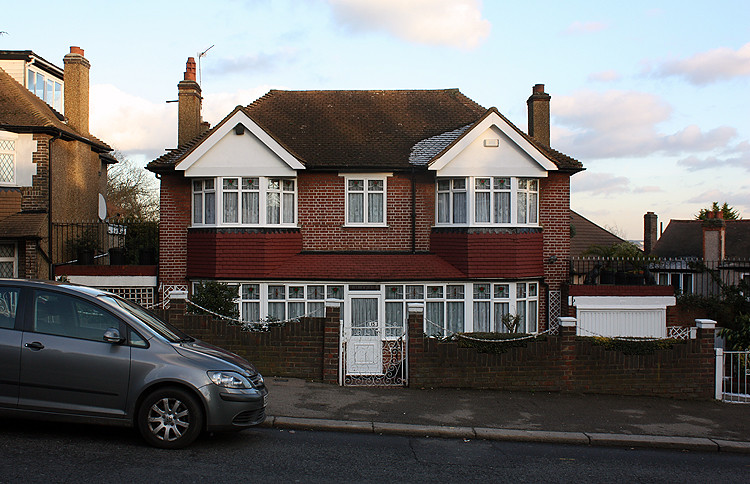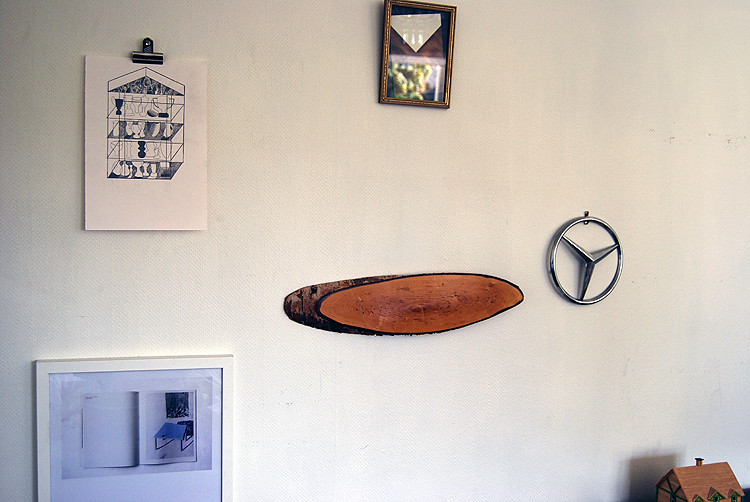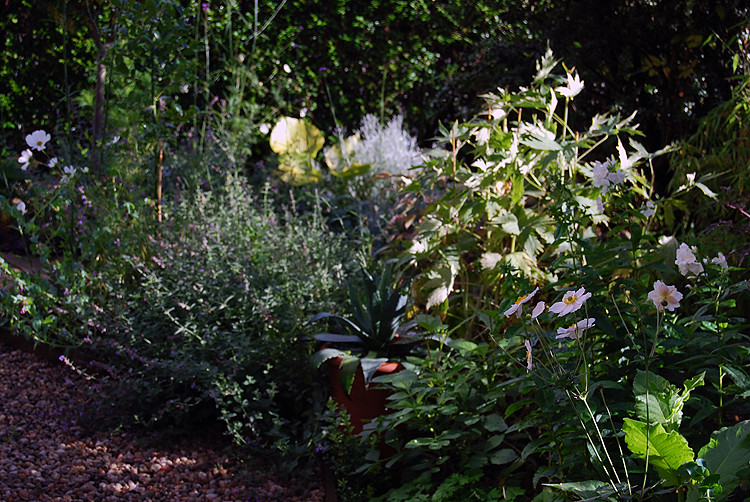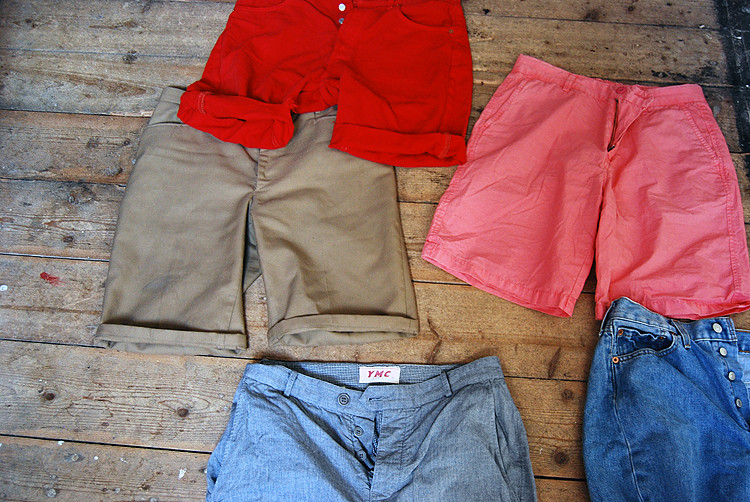
Sydenham Hill, London
THE CONSERVATIVE APPROACH
In recent decades, numerous books have appeared aimed at the middle classes and their ordinary ‘period’ suburban homes, including even the much maligned Tudorbethan semi. In a way this seems like a democratization, but they tend to advocate a didactic conservative or restorative approach to house exteriors; evolution is frowned upon. Houses of Britain - The Outside View, (Prizeman, 2007) with a foreword by the Duke of Gloucester, is one example. The human allusion is made again - ‘the face of the house is the face of the [person] it was built for’ (p. 8) - but, rather than suggesting that this face should adapt itself to changing times, perhaps accessorising with a new door or paint colour in the way one would add some earrings or this year’s shade of lipstick, it is claimed that ‘to destroy or change the face of a house is to lose or alter exact evidence of the past.’ (p. 8) The Duke, in a rebuke to all aspirational homeowners who would dare to add a triangular pediment or faux-leaded panes to their little houses, helpfully points out that ‘After all nobody’s fooled if you put a Rolls Royce bonnet on a mini.’ (p. 7) It is difficult to read this as anything other than a yearning for a past where the proletariat knew their place and were content with it.
Barrett and Phillips’ Suburban Style (1988) contains a kind of rogues’ gallery of good houses gone bad, with captions like ‘A basically unassuming house has been turned into an eclectic nightmare’ (p.190) underneath a photograph of a modest dwelling with a particularly elaborate Italianate balustrade. Another image shows two houses in a terrace, one with its timber casements, porch and front door all intact, the other comprehensively endowed with aluminium picture windows; it bears the legend ‘A well-restored small Edwardian house contrasts with its sadly transformed neighbour.’ (p.197) But would the approved house’s poignant beauty not be diminished if the threat of the double glazing salesman was not always hanging in the air? De Botton (2007) writes about how glimpsing a beautiful stranger in the street makes us feel sad, partly because we may not possess them but also because we know that such beauty has a finite lifespan. Is this not part of the attraction to a perfectly preserved house? And will the authors feel the same if, in the future, someone chooses to replace the plastic garage door of a ‘noughties’ estate house with a timber one?
Front gardens too can be revealing about people’s aspirations. In Bartholomew’s (1998) Mitford-aping Yew and Non-Yew, he describes the upper-class garden:
The formal lines are often marked by hedges - frequently yew for the high ones and box for the low. Within the borders, species plants or old varieties are preferred; they are considered more "natural". Their names are preferred, too. Rosa 'Comte de Chambord' is more welcome than Rosa 'Bobby Charlton' or 'Sexy Rexy' (p. 32)
Box in particular is widely used an urban expression of affluence. To the untrained eye it may resemble weedy privet, but it is slow-growing, and therefore expensive. I surveyed the front gardens in the section of _____ Street including Julia’s house whose residents (at least in terms of property values) might be considered middle to upper-middle class and found that eight out of the twelve contained box. Incidentally, an acquaintance recently mentioned telling her mother that she liked magnolia trees, and her rebuke was that magnolias are ‘suburban’. In this context, ‘suburban’ could well be substituted with subhuman.
The East Dulwich Forum, serving the formerly lower-middle class district now synonymous with ‘yummy-mummy horrors’ (Dyckhoff, 2010) and famed for its purveyors of Cath Kidston-type idealised Englishness, contains some intriguing insights into its residents’ values. bigbadwolf chastises another forum user, Woof:
I bet you're one of those attention seeking imbeciles that festoons their property with gaudy christmas decorations aren't you Woof. I bet your house looks like something you'd find in Basildon doesn't it, you new money mincer! (East Dulwich Forum, 2009)
He then goes on to suggest Woof probably had Scottish parents, but the key citation is Basildon. To certain members of the urban middle classes, garish Christmas decorations aren’t just signs of new money, but of an inferior, suburban or ‘exurban’ (and worse, Essexurban) attitude.
TASTE AND THE PROBLEMS WITH READING IT
It is important at this point to think about the notion of kitsch. The Modernist view was that kitsch was something pleasurable that was too easy, perhaps something that ‘strives for an effect at odds with its true and proper purpose.’ (Bayley, 1991, p.103) Garden gnomes, plastic butterflies, the christmas decorations bigbadwolf so objected to, fake half-timbering and Bill’s tiled front garden could all be cited as examples of it. Greenberg compares the ‘kitsch’ of Repin to the real art of Picasso. The kitsch can be enjoyed without effort but the ‘peasant’s’ circumstances ‘do not allow him enough leisure, energy and comfort to train for the enjoyment of Picasso.’ (Harrison & Wood, 1992, p 539)
It is less useful to think of taste in terms of the way things look than as a product of the ideas that brought them into existence. In attempting to understand taste, we cannot attempt to judge the form, a matter of design, objectively. The predominant contemporary stance is that no style is intrinsically better and that ‘perfect art is possible in any subject matter or style.’ (Gaut & McIver Lopes, 2008 p. 389) We must instead study the spirit that gave rise to it. An individual’s taste is ‘utterly dependent on ideas of consumption fostered in industrial and post-industrial cultures’ and we, consciously or otherwise, reveal ourselves through our consumption. ‘If good taste means anything, it is pleasing your peers; bad taste is offending them...taste is more to do with manners than appearances. Taste is both myth and reality; it is not a style.’ (Bayley, 1991 p. 61)
De Botton’s explanation for the peculiarities of taste is simple: ‘What we seek, at the deepest level, is inwardly to resemble, rather than physically to possess, the objects and places that touch us with their beauty ... We respect a style which can move us away from what we fear and towards what we crave.’ (De Botton, 2007 p.152) In a harsher past of greater social unrest, ornate, sophisticated styles were favoured by the elite. Then, having had their fill of luxury and ease, they wanted something more elemental: unadorned concrete walls, minimalism.
Nonetheless, it is dangerous to rely too heavily on this as a formula. Taste which is too ‘good’ can be read as a sign of conformity and insecurity. It is what George Bernard Shaw described as a kind of ‘moral cowardice.’ (Bayley, 1991 p.67) And of course, as Dorfles (1969 cited in Bayley, 1991 p.67) noted, the meaning of a kitsch object (for example) can be transformed in a cultivated setting. Think of that notorious icon of front garden kitsch, the gnome: Philippe Starck reappropriated it in stool form for Ian Schrager's Saint Martin's Lane Hotel, a regular in articles about so-called ‘hip hotels’. The stools are described as being ‘very special characters that are striking on account of their originality and non-conformism.’ (Exit Art, 2010) Would anyone think this if one were placed in a rockery in the crazy paved front garden of a 1930s semi?
There is a house on Bushey Hill Road, Camberwell, which has a full compliment of the usual urbane accoutrements: refurbished sashes, a front door in a shade of teal verging on grey, standard olive trees in pots. It also has an illuminated number in its fanlight, in strident blue neon of the type more associated with signs for cheap barbers and greasy spoons. In this context, it is clever, knowing, a bourgeois creative injoke; it is like an art student from Primrose Hill experimenting with Kappa sportswear.
The notion of the paradox of consequences comes into play as well - an action can often produce an outcome diametrically opposed to that which was originally intended. Imagine ‘Joe Public’ wins the lottery and so wants a house that is extremely classy, its pediment and fountain smacking of the landed gentry. He instructs architects and designers and ends up with something that to the ‘cultivated’ eye is nouveau riche, crass and trite, exposing him for what he always was.








